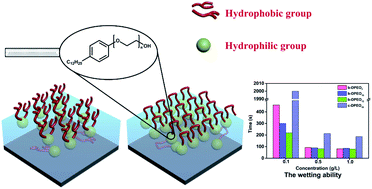Synthesis, characterization, and functional evaluation of branched dodecyl phenol polyoxyethylene ethers: a novel class of surfactants with excellent wetting properties†
Abstract
A series of branched dodecyl phenol polyoxyethylene ethers (b-DPEOn) were successfully synthesized via alkylation and ethylene oxide addition reactions. The alkylation reaction was conducted by using a branched internal olefin as the raw material. Furthermore, the conversion rate of the branched dodecene was measured to be 98.1% and the selectivity towards branched dodecyl phenol (b-DP) was 95.9%. Moreover, b-DPEOn (b-DPEO7, b-DPEO10, b-DPEO12) were obtained via the reaction of ethylene oxide with b-DP. Notably, b-DPEO10 can efficiently reduce the surface tension of water below 31.55 mN m−1 at the critical micelle concentration (cmc) and the cmc value in water was approximately 1.3 × 10−2 g L−1 at 25 °C. The preferable wetting ability of b-DPEO10 was superior to that of commercialized dodecyl phenol polyoxyethylene ether (c-DPEOn), so it will be promoted and used in the textile and pesticide industries.



 Please wait while we load your content...
Please wait while we load your content...